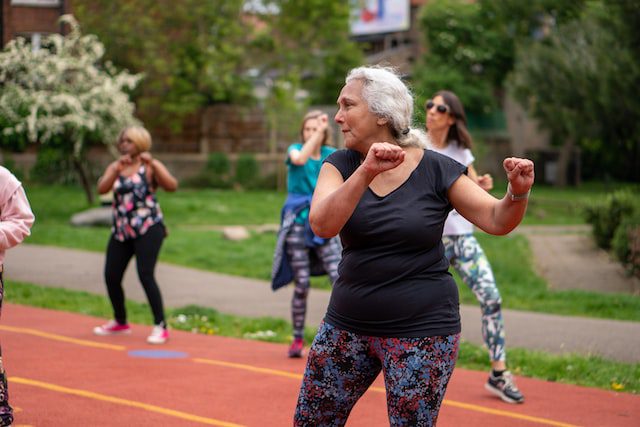Retirement marks the end of a long career and the start of a new chapter in life, with so many things to do. From staying active to exploring new interests, there is something for everyone when it comes to the next phase in your life!
In this article, we will cover a few ideas to help you make the most of your later life, no matter your financial constraints. That way, you can make sure you make the most of your golden years.
One of the most relaxing and rewarding activities you can do is gardening. Gardening is a great way to get outside and get some exercise. Spend some time tending to your plants, and you’ll reap the rewards of your labor. You can grow your own fruits and vegetables, which can save you money on groceries. Planting different vegetables and fruits also helps to diversify your diet, exposing you to new flavors and tastes.
Gardening also helps to bring the beauty of nature into your home. You can choose flowers that will attract butterflies and other wildlife to your garden. You can also pick out herbs and other plants that will give your home a nice aroma.
Adding a few plants can make any indoor or outdoor space comes with many benefits. It makes the space feel inviting and relaxing. Plus, you can use fresh herbs to flavor your meals and make them more enjoyable. Gardening can help you to enjoy nature while providing you with the means to improve your health and wallet.

Retirement is a great time to travel and see new places. You can plan a road trip, take a cruise, or visit a foreign country. Whether you choose to explore your own backyard or journey to the other side of the world, travel can be a great way to spend your retirement.
Road trips, in particular, are a great way to travel in retirement. You can take your time, see the sights, and discover places you never knew existed. You can plan a weekend getaway, or a longer trip spanning several weeks. With a road trip, the possibilities are endless.
Cruises are another great way to travel in retirement. Cruise ships offer a variety of destinations and amenities, from all-inclusive packages to themed cruises. You can choose a shorter cruise, or a longer voyage that spans multiple days. Cruises provide the perfect opportunity to relax and explore new places.
Finally, visiting a foreign country can be an exciting way to spend retirement. You can plan a multi-week vacation, or a longer trip of several months. Exploring a new country allows you to immerse yourself in a different culture, meet new people, and experience a place like never before.
No matter how you choose to spend your retirement, travel can be one of the best ways to make the most of it. From road trips to cruises to foreign countries, the possibilities are endless. So make a plan, choose a destination, and start exploring the world!

Photography is a wonderful way to celebrate your retirement and to capture memories. You can express your creativity by taking photos of your travels, your garden, or your family and friends. With a digital camera, you can quickly and easily share your photos with friends and family. You don't have to be an expert photographer to enjoy the hobby. Amateur photographers can use simple editing software to enhance their photos and create beautiful works of art.
If you're worried you won't have enough money, don't! You don't need expensive equipment to get started. You can find affordable cameras and lenses online or in retail stores. Investing in quality equipment will help you take better photos, but it is not necessary for beginners.
You can also find tutorials online to help you learn the basics of photography, such as composition and lighting. With a bit of practice, you can create stunning photos that will be cherished for years to come.

Cooking is a fun and rewarding hobby that can also be a great way to entertain friends and family. You can start off by trying out new recipes and develop your skills in the kitchen. Or if you already know some of your favorite dishes, you can practice refining them.
Cooking can be a great way to relax and unwind. With the extra time you have in retirement, you can experiment with different cuisines, master the basics, or just enjoy the process of trying something new. You can also take cooking classes to learn the latest techniques and recipes. Whatever you choose to do, it is sure to be a rewarding and enjoyable experience.

Knitting and crocheting are both relaxing hobbies that can also be productive. You can make beautiful gifts for friends and family or even start a small business selling your creations. With a bit of practice, you can create almost any item you can imagine. From hats and scarves to sweaters, blankets and more, the possibilities are endless.
Not only are these activities enjoyable, but they help keep your mind sharp. With each stitch and each project, you are challenging and exercising your brain. Plus, the accomplishment of completing a project and seeing the final result can be very rewarding. In addition, knitting and crocheting offer a great opportunity to get together with friends and fellow hobbyists. It’s a wonderful way to stay connected, share your stories and make new friends.

Painting can be a great way to express your creativity and make beautiful pieces of art in retirement. You don't have to be an expert to get started, as there are many different tutorials and classes available for all skill levels. If you are just starting out, there are many online tutorials that can help you learn the basics of painting. You can even take a class at your local art supply store or community center to get an introduction to painting and learn more advanced techniques.
No matter what your skill level, there is something for everyone when it comes to painting. You can create stunning pieces of art to show off to your friends and family, or create something meaningful just for yourself. Painting can also be a great way to relax and de-stress after a long day. So if you're looking for a creative outlet in retirement, painting can be a great way to explore your creativity and make some beautiful works of art.

Writing is an excellent way to express your thoughts and experiences. Retirement is a great time to start a blog or write a book. You can document your journey through retirement or share your life experiences with your family and friends. It can also be beneficial to keep a journal. Writing down your thoughts, feelings, and goals can help you stay focused on what matters to you.
Retirement is a wonderful time to explore new passions. Writing is a great way to do this. Whether you are looking for a way to connect with others, document your journey, or simply release your thoughts, writing can be a fulfilling activity. You can start a blog, write a book, or keep a journal. It’s up to you how you choose to express yourself. Writing can be a great way to stay productive, motivated, and engaged in retirement.

Retirement is the perfect time to focus on physical and mental health. Staying active is key to a healthy retirement, and there are many ways to do this. Going for regular walks or joining a walking group is a great way to stay in shape. If you're looking for something a bit more intense, you could look into joining a local gym and taking classes or using the gym's equipment.
Exercise isn't the only way to be active in retirement. Take up activities that keep your brain healthy, such as reading, puzzles, and games. Doing something that challenges your mind can help prevent cognitive decline and keep your thinking sharp. There are also many online resources and classes available to help you stay mentally active.
No matter what activities you choose, staying active in retirement is essential for both physical and mental health. Incorporating exercise and activities that challenge your mind into your daily routine can help you make the most of your retirement.

Woodworking is a great hobby for those who enjoy working with their hands and creating something from scratch. Whether you’re a beginner or a skilled craftsman, metal and/or woodworking is an activity that can bring hours of enjoyment and satisfaction in retirement.
From furniture to toys to decorative items, there’s no limit to what you can create. You can use plans and patterns to guide your project, or design something entirely of your own. You can even take classes or join a woodworking club to learn more skills and techniques. With the right tools and materials, you can make everything from birdhouses to cabinets to rocking chairs.
Metal and Woodworking are both challenging and rewarding. Not only will it help keep you active, but you’ll also have beautiful items to show off when you’re finished. Plus, you can even sell your creations if you choose to. So don’t be afraid to get your hands dirty in retirement and try woodworking as a hobby.

Family is a fundamental part of retirement, and there are many ways to enjoy it. One activity to try when you visit family is researching your family tree. Put your detective skills to work by finding out information about your family history, and even create a family tree.
Another great way to spend time with family in retirement is to mentor young people in your family or community. This is a great way to give back to those coming up in the world, and you can share your hard-earned knowledge and life experience. It can also be a wonderful way to connect with the younger generation and spend quality time with your own family.

Retirement is a great time to make meaningful connections with people in your community. Joining clubs centered around your hobbies and interests is a great place to start. Not only will it give you something to do, but you can make friends with people who have similar interests.
Additionally, taking volunteer positions at local charities, animal shelters, or special events is another great way to make extra friends. Social connections are incredibly important for your physical and mental health, so take advantage of the opportunity to form meaningful relationships.

Whatever your retirement plan, it's the perfect time to pursue activities and adventures that bring true joy, a sense of fulfillment and overall well being.
From engaging in hobbies, exploring new countries, spending time with family, to learning new skills, there are many great opportunities available to seniors that can help them maintain physical and mental health, build new relationships, and enjoy their golden years to the fullest!
Retirement is about more than just having fun; it’s also about financial planning for the future and leaving a secure legacy for your loved ones.
Taking control of your financial security with a final expense plan is the best way to ensure that your family is taken care of when you’re gone, and give you the peace of mind you need to truly enjoy your retirement.
With the right insurance policy, you can make sure that your loved ones are provided for and your legacy is secure.
Click the button below to get started now.
While retirement can be a time of great excitement, it's no secret that it can also be a time of great stress and anxiety. That’s why it’s important to remember there are things you can do to keep healthy habits in retirement.
In this article, we'll explain the importance of staying healthy in retirement. Plus, we'll give you great tips on how you can be your healthiest self late into your sunset years.
Let's get into it!
There are many reasons why it's important to try for better health in retirement. First and foremost, your overall health is your most valuable asset. Without good health, it's difficult to enjoy yourself to the fullest.
Additionally, staying healthy can help you keep your independence while saving money on healthcare costs down the road. That means you don’t need to worry about becoming a burden on your loved ones.
Of course, there's more to existence than money. Keeping a healthy lifestyle in retirement also gives you the opportunity to spend more time with loved ones, travel the world, and pursue new hobbies and interests. In short, it allows you to live your best sense of self!

Now that we've talked about why staying healthy is so important in retirement, let's talk about how you can actually do it!
Here are a few great tips :

One of the first steps to take control of your health is understanding the risks associated with retirement age.
As we age, our bodies become more susceptible to diseases and conditions such as heart disease, stroke, cancer, diabetes, Alzheimer's disease, and arthritis. It's important to be aware of these risks so that you can take steps to prevent them — especially if health issues run in your family history.
That’s why it’s a good idea to see your doctor for regular checkups and screenings even if you feel fine. Doing so helps to catch any potential health problems early on so that they can be treated effectively.

Eating a balanced diet is crucial for maintaining good health at any age. But it's especially important as you get older since your body becomes less able to absorb nutrients from food as efficiently as it once did.
Try to make sure your diet includes plenty of fruits, vegetables and whole grains. Also, stick to lean proteins such as chicken, fish, tofu, nuts, and seeds. Finally, don’t forget to eat healthy fats like olive oil, coconut oil, or avocados every day — especially if you have high blood pressure.
Eating right will help boost your immune system and keep chronic conditions at bay. At the same time, you'll find yourself with more energy to do the things you love and stay independent.

Regular exercise is another key component of a healthy lifestyle. It improves cardiovascular health, strengthens bones and muscles, reduces stress levels, boosts brain function, and more.
Aim for 30 minutes of moderate exercise most days of the week. If you're not used to exercising, start off slowly by taking a brisk walk around the block. Then, gradually increase the intensity level until you reach your goal.
Outside of brisk walks, there are plenty of other ways to stay active and maintain your health as you age. Swimming laps or taking a gentle yoga class are great exercises for seniors because they're low-impact and easy on the joints while still maintaining good bone health.
Gardening, tai-chi, and dancing are also great ideas for older adults to stay physically active.
In the end, it’s important to find activities that you enjoy and that fit into your lifestyle.

If you smoke, now is the time to quit. Smoking is one of the leading causes of death and illness worldwide, so quitting will do wonders for your health. Better yet, you save a lot of money when you don’t buy cigarettes!
More money in your pocket means you have more to spend on hobbies and your loved ones.
If you are struggling to quit smoking, try speaking with your doctor about nicotine replacement therapies or other medications that can help. You can also try speaking with a smoking cessation counselor for more advanced tips and advice to cut the habit.

Getting a good night's sleep is essential for good physical health, but also better mental health. Most adults need seven or eight hours of sleep per night. However, it's not uncommon for many seniors to notice their sleep patterns change as they age.
Try to set up a nightly routine, and do your best to keep a consistent sleep schedule. Keeping a consistent schedule can do wonders for your sleep quality.
If you're having trouble sleeping through the night, talk with your doctor about ways you can improve your sleep hygiene.

Everyone feels stressed now and then, but it can take a serious toll on your health if it's not managed effectively — especially in your golden years. Moreover, it can harm your relationships with those closest to you.
If you're feeling stressed, try relaxation techniques such as meditation, yoga, or deep breathing exercises. Additionally, make sure to schedule time for activities that you enjoy and make time for social interactions with loved ones and friends.
It's also good to note the health benefits for both mind and body when you stay active into your retirement years. Physical activity not only improve your physical fitness, but your mental fitness as well.
Not to mention, when you are physically active, you can reduce your blood pressure. That means it's easier to live a longer life, stress free.

Another great tip for a healthy lifestyle is to keep in touch with your friends. Staying connected with friends and family is an important factor for maintaining good mental health. It can help you maintain a sense of purpose in life, while also keeping your mind sharp.
If you live far away from your friends, try using technology to stay connected. Video calling apps such as Skype and FaceTime make it easy to have face-to-face conversations no matter where you are in the world.
Staying social has been shown long to have positive effects on your overall well being, so don't forget about activities like bridge club or book club!
There are many activities to help you stay in touch with your community. Other activities popular with older adults include, but are not limited to:
To find out what social activities are happening in your area, check with your local Chamber of Commerce, religious group, or senior centre. You can also try searching online or asking your friends and family for recommendations.

Finally, make sure you have adequate life insurance coverage in case of an unexpected medical event or accident.
A good final expense plan provides peace of mind in knowing that you're prepared for whatever comes your way. That means you don't ever have to worry about leaving your loved ones with your debt or funeral expenses when that time does arrive.
For anyone with prior health conditions preventing you from getting coverage, or anyone on a fixed income worried about expensive premiums, you may benefit from learning more about an affordable No-Medical policy.
Not only are these plans affordable, but they also won't turn you down — no strings attached.

Keeping healthy habits in retirement are important for many reasons. With that said, it's not always easy to do. That's why it's important to be proactive about your health and take steps to prevent potential problems before they arise.
By following the tips outlined in this blog post, you can help ensure that you'll enjoy a long, healthy and happy retirement!
Now that you know how to enjoy your retirement in great health, it's time to start thinking about life insurance. With that said, we understand that finding the right coverage can be complex and confusing.
To learn more about how life insurance protects you from whatever comes your way, our expert team of advisors are ready to help.
Let us answer any questions you may have so you can find the perfect coverage for your life and circumstances.
Click the button below to get started now.
GET STARTED TODAY
Budgeting in retirement is crucial, especially when you live on a fixed income. It doesn't matter if you retire early or you have a late retirement. With careful retirement planning, you make your nest egg last as long as you need it to.
In this article, we discuss how to stretch your retirement savings in order to make them last longer. We cover budgeting strategies and how to make your money work for you.
Making a budget is an important step to ensure your retirement savings last. In short, when you have a budget and spending plan, you can better track and assess the things you need to pay for in life.
With that said, before we delve into more specific money saving tips, let’s explore how to set up your budget in the first place!

The first step to take when budgeting for retirement is to estimate your retirement income. This includes all sources of income, such as pensions, government benefits, and investments. Once you know how much income you'll have each month, you can start making a budget.
There's no one-size-fits-all answer to this question. The amount you need each month depends on factors like your lifestyle, health, tax-costs, and where you live. However, as a general rule of thumb, you can expect to need about 70% of your pre-retirement income.

Once you have an estimate for your retirement income, you can estimate your retirement expenses.
You'll need to account for out-of-pocket costs like housing, food, health care, tax payments, as well as investment or transportation expenses. Remember to include leisure and entertainment expenses. And, of course, you'll need to account for unexpected expenses.
The biggest expense in retirement is often housing. This includes costs like mortgage or rent payments, property taxes, and maintenance. Other significant expenses include food, transportation, and health care.

The monthly cost of health insurance premiums often increase in retirement. This is because you'll likely need to spend more of your income on health care than young people. Knowing your family health history is one of the best ways to guess what you might need to pay down the road.
Another common expense that increases in retirement is travel. So long as you have the income, spending time in new places around the world is great personal care, as it helps you feel more fulfilled in life.
There are a few expenses that tend to decrease during retirement. One is work-related expenses, such as commuting costs, business attire, and income tax. Another is child and family care related expenses, such as education, or your child's wedding.

If you're on a small budget, there are a few things you can do to reduce your monthly expenses and extend your retirement savings.
Here are some tips on how to budget your retirement savings:
You'll want to take a close look at your expenses and make changes where necessary. This may include cutting back on non-essential expenses, such as dining out or travel. It's also important to make sure you are not overspending on housing costs.
In short, you'll want to ask yourself, "Does this help me achieve my financial goals?" If the answer is no, it may not be necessary.

One of the best ways to make your retirement savings last longer is to live below your means. This means spending less than you earn from your pension and saving the difference. When you live frugally, you have more money to live your best possible retirement life.
For seniors who've fully paid their mortgage, downsizing to a smaller dwelling can save a lot of money on things like property taxes, utilities, and maintenance. Since you don't need to go to work, try relocating to a walkable or bikeable neighbourhood. You won't have car payments, and you'll get exercise while meeting people in your community.

Final expense life insurance can help your loved ones cover the cost of final expenses, like your funeral and outstanding medical bills. It is a really good idea to get one of these personal insurance plans, especially if you have debt in your retirement years.
That's because these plans ensure your spouse and family won't inherit your debt (or its rising interest rates) in order to pay for your final expenses. Your benefits could even be used to make charitable donations on your behalf!
At the end of the day, life insurance gives your future the certainty needed to fully enjoy retirement life.

Pensions don't always pay us what we need for spending cash. Here are some ways you can increase the cash you have to spend on what's important to you in life.
With all of the extra time you might have, starting a small business can be a great way to generate income. However, keep in mind new businesses mean new expenses, and new expenses will affect your income and savings. The last thing you'd want is to spend all of the nest eggs saved in your retirement accounts!
That's why another way to bring in some extra cash is to get a part-time job, whether it’s working in a retail setting, food service, or even part-time for your old employer (That is, if they were a good employer!).

Everyone can save money by using coupons and being strategic about where they shop, but this is especially important for retirees who are living on a fixed-income.
Plus, there are often a lot of free or low-cost services and activities available to Canadian seniors, so take advantage of them!
Clubs and groups for seniors often offer discounted rates on things like travel, education, and recreation, so this is a great way to save cash while also meeting people in your community.
Find out if your community has senior gym memberships. Not only do gym memberships help you meet people, but staying active is a great way to reduce health care expenses down the road.

Instead of going out and spending too much of your budget on entertainment, stay home and find ways to have fun for free or very cheap. For example, try calling up some old friends to have a karaoke night.
Another example, reduce your monthly expenses by switching from cable to streaming services.
If you have extra space in their home, you may want to consider taking in a lodger or renting out a room. This can help offset some of the costs of living alone while providing you with a bit of company.
Plus, investing in your home by building a secondary dwelling can significantly raise the total amount of your home's value!

Creating a retirement budget is an important process that will help you make the most of your golden years. By estimating your retirement income and expenses, you can develop a plan that will allow you to enjoy your retirement and stretch your savings.
Creating a budget plan for when you retire helps your life savings last as long into the future as possible. A final expense plan helps you account for the unexpected costs in retirement. That way, you can make your savings last worry-free.
One of our professional advisors is waiting and ready to help you get the insurance coverage you need today!
Building your nest egg is crucial to be financially secure long-term. Whether for your retirement savings, your first home purchase, or a rainy day fund, contributing to a financial nest egg provides stability and certainty for your future.
In this article, we'll break down how to fund your nest egg in Canada. We'll show you how to get started, tips to grow your savings, and how to protect what you save for years to come.
It's a safe bet to assume that you—like most working Canadians—will eventually want to retire. Moreover, when you finally do reach that milestone, it's safe to assume that you—like most Canadians—will also want to retain purchasing power well into your sunset years.
That's where your nest egg comes in.
Although you might have a pension to cover the cost of living, it might not be enough to cover all of your expenses. A nest egg gives you an extra cushion of cash to depend on while you earn a fixed-income.
But before you start saving any money, you'll need to make a plan.
But first...

The expression originates from 17th-century poultry farmers. Each morning, farmers would set aside a small amount of the eggs their hens laid. Rather than selling these eggs, farmers snuck them into their hens' nests the following night. This was believed to influence each hen into laying more eggs, while preventing them from ever stopping.
In other words, the farmers put aside a small amount of their earnings with the goal of achieving long-term success. This is where the modern use of the term comes from.
Brace yourself for some math up ahead! In this section, we'll breakdown how to start building your nest egg.
Note: If you have a spouse, don't forget to repeat these calculations with their earnings and retirement plan so you can factor in the money you'll both need.


You now have the amount you'll need to put away each week for the first year.
But we're not done yet! To protect your money from inflation, increase your contributions by 2% every year (...more on inflation in the next section).

Overtime, money loses its value. That's why you can't just stash your savings under your mattress.
Instead, you'll want to invest your money into a savings account, or invest it into other assets that will appreciate by at least 2% over time. Why 2%? That's the target rate of inflation set by the Bank of Canada. In other words, even if annual inflation is a bit more or a bit less, over time it will likely average around 2%.
One thing to keep in mind before you invest is that all assets are different. Some have greater risks than others. Knowing your risk tolerance, depends on how long you have left to save your nest egg.
Invest in things like bonds and mutual funds; investments that will be worth a modest amount more over time, and likely won't be worth much less down the road.
Your portfolio has more wiggle room when it comes to investing aggressively. Stock investments, and other assets that may go up and down in value in the short term, but are likely to grow in the long term, are more viable investment options for your retirement account.
TIP: If you have a high risk tolerance, but don't want to keep a constant eye on your investment portfolio, ask your investment broker about ETFs and Mutual Funds.
Although the two are different, they both function like their own portfolios—Both independently managed by expert investors. This means they have the potential to grow faster than bonds, while being very low maintenance on your end.

Despite everything you may do to try minimizing any uncertainty around your nest egg investments, sometimes life just happens.
That's why a cornerstone of every financial plan is adequate insurance coverage. To understand how much protection you'll need, ask yourself:
Now go back to the number of years before you'll need to draw from your savings. This will be the duration of coverage you'll want in order to ensure your nest egg reaches the amount needed for retirement time.

The most vital step to keep your money saved for retirement is simple: Keep it in your retirement account!
...Then again, perhaps that's easier said than done.
One tip is to have your bank put your money into investments automatically as soon as you receive the pay from your employer. That way you never have to think about it and can ignore the account until it's time you need to lay into it.
The other great tip is to consider insurance. With the right insurance, you won't have to dip into your nest egg if you ever need the cash for a medical emergency.

With the right plan, and the right protection, you can make sure you'll have enough money for your entire retirement.
Now that you're building your nest egg, you'll want to start looking for your best insurance protection.
Why not start your search with us? Simply fill out our easy questionnaire and get a quote from our expert team in minutes. There are no medical exams, and you are guaranteed to be approved.
Protecting your savings has never been this easy!
Get your free quote now by clicking the big button below:
The holidays can absolutely be a fun time of year: festive celebrations, catching up with friends and family, countless markets, events, and hot cocoa - what isn’t there to love?
This year, as many folks return to in-person events after almost two years of social distancing, you should be aware of some hidden dangers related to the holidays that can pose a hazard to your health and safety. And while accidental death insurance coverage can be a crucial piece of financial planning, the goal is not to have to use it, after all.
Below are four tips to keep in mind to help ensure a safe holiday season and to start off next year in one piece and on the right foot.
After purchasing a life insurance policy, most people fall into the trap of filing it away and never looking at it again until it is necessary. But it is beneficial to regularly review your coverage to ensure that the plan is best meeting your current needs. Cover you purchased 10 years ago may not work for your present situation in life. So, how should you review your life insurance policy? Let’s take a look. (more…)
Whereas practically no one can predict a severe illness or accident, there is a group of people that counts on the probability of suffering a potentially fatal accident throughout adult life: workers in dangerous occupations.
No one enjoys thinking about their mortality, but, unfortunately, those who work in high-risk jobs must prepare for any eventuality, at least financially.
Within federal, provincial, and territorial occupational health and safety legislation, all Canadian workers have some level of workplace protection. Nonetheless, this is not the same for injury compensation insurance. Even nowadays, many workers in Canada are not covered by compensation boards, which means that, if something tragic happens, uncovered workers and their respective families will have to deal with the consequences with little help.
Every year, around 1000 workers die in Canadian workplaces. Regardless of the health and safety measures that companies apply, there is still lots of room for disastrous incidents to happen. From hazardous work conditions to debilitating social environments, many factors can put someone's health and life at risk.
A few years ago, Adzuna, a search engine for job advertisements, conducted a study taking a closer look at Canada’s most risky jobs. As the research revealed, even with technological advances and stricter health and safety regulations, there are many industries where the risks to workers are still remarkably high.
To protect their families and loved ones, these workers often consider applying for an insurance plan that can guarantee their financial independence and security. At Speciality Life Insurance, we have the right solution for these cases: Accidental Death and Dismemberment insurance.
Accidental Death is, very often, a clause or rider connected to a life insurance policy. It refers to a payment due to the beneficiary of an Accidental Death insurance policy, and it is, generally, paid in addition to the standard benefit. However, many insurance companies also sell this product separately. That is the case of Specialty Life Insurance. We offer an Accidental Death and Dismemberment insurance plan that provides coverage up to $250,000, with no medical exams or health questionnaires required.
As the name suggests, this policy pays benefits in the case of a person’s accidental death or dismemberment - which is the loss of body parts or functions. It covers exceptional circumstances, such as traffic accidents, falls, drowning, and accidents involving heavy equipment or hazardous materials. This means that if you lose your life or ability to work while on the job, you can receive up to 200% of the principal sum amount, depending on the occurrence.
While some jobs are reasonably safe, others represent a vast and continuing risk to workers’ health and life. According to AWCBC (Association of Workers’ Compensation Boards of Canada), based on total fatalities, Canada’s most dangerous industries are quite varied and can present, at times, up to five fatalities on the job per workday.
Contrary to common belief, firefighters and police officers are relatively secure in terms of workplace hazards compared to industries like mining, commercial fishing, or construction.
If your professional life is connected to any of the industries we are going to mention below, we strongly recommend considering an Accidental Death insurance plan. Assuming that your job carries a lot of risks (and potentially fatal ones), there is nothing like ensuring your family’s peace of mind and economic security by getting an insurance policy.
Mining is one of the most dangerous jobs in the world, accounting for over 12,000 deaths each year. With falls of ground and rock bursts occurring frequently, the mining and quarrying workers are often at risk. Besides, as underground mines become older and deeper, they are generally more prone to disastrous incidents.
Considering that in Ontario only mines are operating at depths approaching 3,000 meters, it is easy to assume that the risks are immensely high in a country like Canada. Mining environments are tough settings to work in, and the risks aren’t only physical - they are also ergonomic and psychological. From asphyxiation to stress and depression, the likelihood of facing physical and mental health problems in this sector is immense.
As one can imagine, construction zones can be particularly hazardous work environments, especially in a country with harsh weather conditions like Canada. Working in the construction of buildings, bridges, and city infrastructure isn’t for the faint of heart. But even the most courageous and careful workers are constantly at risk in this sector.
Getting struck by objects and materials, being exposed to the elements, air contaminants and fires, and handling heavy machinery, tools, and equipment, are some of the main dangers workers face daily. But here’s another significant threat that is not adequately recognized: in the construction industry, workplace violence is a huge problem, counting as one of the biggest causes of injuries at work. This also has a significant impact on the worker’s mental health, increasing their chances of developing chronic stress, anxiety, and even depression.
Iron and steel workers handle dangerous equipment on a daily basis, but, in the profession, the real killer is high heights. These workers usually work on skyscrapers, city buildings, and bridges, raising, placing, and uniting iron or steel columns and trusses. This makes any fall, slip, or trip potentially deadly.
Besides that, iron and steel workers are also at risk of suffering non-fatal injuries that can hurt them for long periods or even indefinitely, like burns, muscle strain, and even dismemberment. Many studies have found that those who work with iron and steel show a significantly increased risk of lung cancer. This is mainly due to the chemicals (like uranium, arsenic, or asbestos) and airborne toxins frequently present in work environments.
While major airline pilots have low job fatality rates, practically any other flight and air professional face health risks and a high probability of fatal accidents.
Flying new planes or those recently repaired can be perilous for test pilots, especially if we consider the influence of adverse weather conditions.
Helicopter pilots also face many risks, mainly when they perform rescue missions, while engineers face daily exposure to hazardous chemicals and dangerous materials. Finally, the psychological effects can also be substantial. Pilots, navigators and flight engineers have erratic schedules and are usually away from their homes and families for extended periods of time, which can lead to loneliness and, in some cases, depression.
Canada has a proud lumberjack tradition. However, not many people are aware of how the work of a lumberjack can be extremely demanding and potentially dangerous. Falling trees, adverse weather conditions, heavy equipment, dangerous environment… These are some of the risks that loggers and forestry workers face every day, both in the woods and in the workshops.
However, one of the biggest problems relies on the fact that these jobs generally take place in isolated locations, far away from hospitals. As a result, when a severe accident occurs, workers face even higher risks of developing an untreatable injury or even dying.
Even though the industry is becoming safer, there is no way around this: logging and forestry is a dangerous career choice.
Hostile marine environment, bad weather conditions, malfunctioning gear, injuries from fish spines or bacteria, and even drowning… No wonder the fishing industry has one the highest incidence of workplace fatalities!
According to the Senate Committee on Fisheries and Oceans, the commercial fishing industry has the highest death rate out of any other employment sector in Canada. But there are other risks to consider. Fatigue from long hours of work and night shifts, lack of food and kitchen hygiene, and loneliness are other significant health issues in the fishing industry.
Exhaustion from long hauls, bad weather and road conditions, and maneuvering large loads that can become unbalanced are just some of the dangers faced by truckers. According to the Canadian Automobile Association (CAA), more than 100 tow-truck drivers in North America die each year on the job. But non-fatal injuries are also quite common, especially musculoskeletal ones. In fact, Peripheral Arterial Disease, caused by a blockage in blood vessels around the body, is commonly known among workers as the Trucker’s Leg.
But there is more. The loneliness, lack of exercise, sleep, and healthy eating that truck drivers face, also potentiates their chances of getting depression, hypertension, diabetes, obesity, and even suffering a stroke.
Farming seems, for most people, like a hard and yet peaceful occupation. Nonetheless, this is far from the truth. Nowadays, modern farming practices generally involve the heavy use of motorized vehicles. As a result, many fatal injuries occur while operating these vehicles and machinery.
But that’s not all. Farming situations present many respiratory hazards to workers, which often leads to severe respiratory diseases, such as chronic bronchitis, asthma, and permanent lung damage. Skin disorders and hearing loss are also two common problems, affecting mainly those exposed to grain dust. Nonetheless, chemical toxicity and accidents related to machinery are the most dangerous risks associated with farm working.
Pipefitters, plumbers, and steamfitters have one of the highest rates of injuries and illnesses of all occupations in Canada. Exposure and proximity to substances like lead, sulphur dioxide, adhesives, and solvents, not to mention flammable products, is one of the risks these workers face on a daily basis.
Besides, working in confined spaces and in awkward positions also potentiates their chances of getting musculoskeletal injuries, burns, and eye injuries. For some, exposure to sewage and contaminated soil can also cause severe health problems, such as infections by E. coli, parasites, hepatitis, and tetanus.
Garbage and recycling collection is a much more dangerous job than most people realize. In fact, it is one of the top five most dangerous jobs in America, surpassing farmworkers, steelworkers, and powerline installers.
In addition to working with big and dangerous machines, these workers are also exposed to the risks posed by hazardous materials and traffic accidents caused by fatigue - it is essential to keep in mind that commercial drivers often start their route before 2 a.m.
Injuries from broken glass, used needles, nails from construction sites, and many other waste items, are quite common. Still, being struck by a vehicle remains the leading cause of fatalities in the industry.
Willingly or not, many people end up in jobs that continuously put their safety in peril. If this is your case, don’t underestimate the need to purchase a policy. Investing in an Accidental Death Insurance plan is the best way to protect you and your loved ones if something happens to you at work.
Qualifying for our Accidental Death and Dismemberment insurance is quite easy: you only need to be a permanent Canadian resident between the ages of 18 to 69. As already stated, you don’t have to go through medical exams or questionnaires to receive the insurance you need. Even if you had or are currently facing health issues, you can easily apply for this plan.
If you have any doubts regarding this policy or any other that Speciality Life Insurance offers, don’t hesitate to get in touch with us. Our specialized team will be delighted to walk you through the process of buying insurance and prepare a quote for you.
Hypertension, also known as high blood pressure, is a major cause of premature death worldwide. According to the Global Health Observatory, it causes over 7.5 million deaths per year, and it is one of the leading causes of coronary heart disease and stroke.
In Canada, even with all the progress made to improve hypertension detection, treatment, and control, it is still the predominant risk factor for cardiovascular disease, affecting one in every four adults.
Since it is the most common chronic condition among older adults, the Canadian Hypertension Society recommends that all adults have their blood pressure checked every year, or, if additional risk factors are present, more frequently, so that they can take the appropriate measures to control and treat it.
Considering that hypertension can profoundly affect your life in many ways, it is recommendable to monitor it, especially as you get older and more vulnerable to diseases. If hypertension is something you worry about, information is key to understand it, and, most importantly, prevent it.
Below we will explain high blood pressure and its main risk factors, how to prevent and treat it, and how you can get insured with this condition - because yes, it is possible!
Blood pressure is a measure of the force of blood against the walls of your blood vessels, known as arteries. Blood pressure readings are in millimetres of mercury (mmHg). The top number (called systolic) indicates the arteries’ pressure as the heartbeats, while the lower number (diastolic) indicates the pressure as the heart rests between beats.
Normal blood pressure is systolic blood pressure less than 130 mmHg and diastolic blood pressure less than 85 mmHg. As such, to be diagnosed with hypertension, you need to showcase a systolic pressure of 130+, or a diastolic pressure of 85+, that stays high over time.
High blood pressure can harm your body in many ways, and the worst part is that it can do so quietly, without developing noticeable symptoms. In time, it can severely interfere with many organs and body functions, causing, among many other things, kidney failure, coronary artery disease, heart attack, stroke, dementia, blindness, and sexual dysfunction.
Since there are very few warning signs associated with hypertension, many people are unaware of the problem. But other people identify a wide range of symptoms, including headaches, nosebleeds, irregular heart rhythms, vision changes, muscle tremors, chest pain, extreme fatigue, and anxiety.
Many refer to hypertension as the silent killer, which is why it is essential to do routine examinations, such as blood tests and electrocardiograms. Worldwide, a significant proportion of people with high blood pressure remain unaware of their diagnosis, and of those who are aware, only a minority manages to get it successfully under control.
Anyone can develop high blood pressure. However, certain hereditary and physical factors can put you at higher risk. These are some of them:
But that isn’t all. There are also many modifiable factors that you should take into account, such as:
If you already have prehypertension (which means that you are likely to develop high blood pressure), or if it runs in your family history, you should start making changes in your lifestyle as soon as possible to avoid further complications. Hypertension is a definite health hazard, so it is advisable to follow the prevention guidelines proposed by organizations like Hypertension Canada. Here is a list of good practices that you should apply to your daily life promptly:
If you already have prehypertension (which means that you are likely to develop high blood pressure), or if it runs in your family history, you should start making changes in your lifestyle as soon as possible to avoid further complications. Hypertension is a definite health hazard, so it is advisable to follow the prevention guidelines proposed by organizations like Hypertension Canada. Here is a list of good practices that you should apply to your daily life promptly:
Regular exercise is one of the best things you can do for your health, but, as statistics show, 85% of Canadians are not meeting the weekly physical activity recommendations. If you are included in this percentage, it is time to change this mindset, especially if hypertension worries you.
Regular physical activity makes your heart stronger. A stronger heart can pump more blood with less effort, which means that blood pressure will be more normalized.
You don’t need to run a marathon or sign up for a gym! Thirty minutes of brisk walking or another aerobic activity per day is more than enough. Besides, there are many ways to make exercise part of your lifestyle without too much inconvenience. For instance, you can start using the stairs instead of the elevator, park farther away from your workplace or the supermarket, take short walks on your lunch break, and incorporate simple stretching exercises into your morning routine.
Being overweight or obese increases your risk of having hypertension, but also of developing cardiovascular disease (CVD), stroke, noninsulin-dependent diabetes, certain cancers, and numerous other disorders. As such, caring about your weight should always be a priority, especially if you are overweight or already have hypertension. There is no magic formula for weight loss. You can follow the most general guidelines (which include avoiding processed food, consuming more fruits and vegetables, drinking more water, and so on), but it is crucial to find a proper plan with the help of a professional.
Every metabolism is different, so the best thing for you to do is get a personalized diet plan from a nutritionist. Then, all you will need is about 30 minutes of moderate-level physical activity regularly to start seeing results.
But keep this in mind: if you have heart trouble or have had a heart attack if you are over 50 and are not used to physical activity, or if you suffer from any type of condition, you should check with a doctor before starting to exercise.
Eating healthy is critical for those who struggle (or fear) high blood pressure. In Canada, several studies related to this matter led to creating The Dietary Approaches to Stopping Hypertension (DASH Diet), which aims to reduce blood pressure through changes in diet. Broadly, it consists of an eating plan rich in vegetables, fruit and low-fat dairy foods, and lower in saturated fat, total fat, and cholesterol.
As research concluded, DASH has an outstanding effect on blood pressure, lowering levels within two weeks of starting the plan. One of the most important elements of this diet is related to the consumption of salt. According to it, Canadians should consume no more than 2,300 mg of sodium (about one teaspoon of table salt) a day. It also stresses the importance of avoiding highly processed foods, just like canned food and sugar-sweetened beverages.
If you are committed to change your lifestyle and become a healthier person, you should also limit your consumption of alcohol and caffeine. According to the DASH diet, you should limit yourself to no more than two drinks a day and, ideally, avoid those that contain too much sugar. Remember: alcohol not only hurts your blood pressure; it is also destructive to the liver, brain, and heart. The same goes for caffeine.
While coffee stimulates the nervous system, increasing alertness, it can also raise blood pressure, especially in people who are not accustomed to the substance. Although caffeine's long-term effects on blood pressure aren't clear, it is always reasonable to limit its consumption, especially if you are sensitive to its effects. If you already have prehypertension or hypertension, you should avoid it as much as possible, especially before activities that naturally increase your blood pressure, such as exercise or weightlifting.
Did you know that nicotine raises your blood pressure and heart rate, narrows your arteries, and makes your blood more likely to clot? Cigarette smoke is a toxic mix of more than 7,000 chemicals, and, as many studies concluded, it isn’t just bad for your lungs; it also damages the heart. Quitting smoking helps your blood pressure return to normal, and lowers your risk of developing recurrent heart attack and cardiovascular death. In fact, according to WHO, if you manage to quit for a year, you will be dropping your risk of coronary heart disease to about half that of a smoker's.
Quitting smoking is quite tricky, but it is achievable and undoubtedly worth the try. If you struggle with it, remember that a medicinal cessation therapy (such as nicotine replacement therapy) can be a great ally on your journey.
A stressful lifestyle can lead to mental health problems and many medical issues. High blood pressure is one of them. This is why taking care of your mental health is as important as caring for your physical body; you can’t have one without the other.
And if you have an anxiety disorder or depressive tendencies, this is even more important.
Most doctors agree that activities that teach you to focus on your breathing help lower blood pressure and general anxiety. As such, if you want to nurture your mental well-being, you could try to practice yoga or meditation. As a study developed by the Department of Psychology of the University of California suggests, yoga can reasonably reduce high blood pressure, while also lowering the risk of heart problems, chronic kidney disease, and strokes. Time to start making some Salutes to the Sun!
High blood pressure is one of the many risks associated with not getting enough sleep. In 2019, the University of Arizona conducted a study connecting sleepless nights with hypertension. As it concluded, something as banal as “a bad night's sleep” could result in a substantial spike in blood pressure the following day. Sleep impacts overall cardiovascular health, and it is not just about the amount of time you spend in bed, but mainly the quality of sleep you are getting.
If you want to enjoy more relaxed and uninterrupted nights, there are some changes you should make to your sleeping routine. First, it is essential to keep a consistent schedule, with at least 7 hours of sleep per night. Then, you can also optimize your bedroom environment (temperature, light, noise, etc.) and try relaxing teas and natural sleep-promoting supplements.
All these suggestions are important, but they might not be enough to reach impeccable heart health. If you are worried about developing hypertension or have been diagnosed with it, you must seek professional guidance.
If a change in lifestyle isn't enough, your doctor will likely prescribe you blood pressure medication, which can range from diuretics to blood vessel dilators.
Even if you manage to control your hypertension, remember: this isn't a problem you can treat and then ignore. You might be able to stop taking blood pressure medication or naturally lower your levels, but maintaining healthy habits is still essential. Keep a nutritious diet, exercise, have a good sleep, and, most importantly, don’t stop monitoring your blood pressure. You can, for instance, buy a blood pressure monitor and frequently check your values. This way, you can keep track of the results and show them to your physician every time you have an appointment.
When applying for a life insurance policy, most companies will ask you to go through a medical exam or answer a comprehensive health questionnaire. This way, based on your health status and family history, they can assess how risky you are to insure. Having high blood pressure is considered a major risk factor because it can lead to severe health issues, such as strokes, kidney failure, or coronary artery disease. As a result, you may be denied coverage, or you may face very high premiums.
Not all insurance companies view high blood pressure the same way, but it is irrefutable that these kinds of health problems make you a very risky (and even inadmissible) applicant.
Luckily for you, at Speciality Life Insurance we can get you covered regardless of your health status or history. Our three insurance plans - Critical Illness Insurance, Accidental Death Insurance, and Final Expense Plan - offer you guaranteed acceptance, so that you can get the coverage you need with no barriers. Your health will not affect your eligibility or rates, even if you were denied insurance in the past.
Our plans are flexible, affordable, and easy to obtain. If you want to see it firsthand, follow our guide on how to buy insurance from Speciality Life Insurance or contact our team of experts. We will be delighted to walk you through the process and show you how simple it can be to get insured - even if you suffer from high blood pressure or any other condition!
No matter how much we decorate our homes and listen to Mariah Carey, we all know the truth: this Christmas won’t feel the same way. There will be no Santa Claus parades, no joyful Christmas markets, no big family reunions at the dining table, and no Winter festivals with snow tubing and ice carving. Even the expression "home for the holidays" doesn't have quite the same ring to it - after all, we have been home all year!
However, there is a thing we won’t give up that easily: the tradition of exchanging gifts. We might not be able to be physically present, but we can still surprise our loved ones with a thoughtful present - and watch them “unwrap” it on a family video call.
In a time when everyone is trying to stay home, we figure that digital gifts make more sense than ever. From subscription boxes to a classic gift card, there are so many gift options to choose from that you will most likely find yourself a little lost and unsure of what to get.
Luckily for you, we have created a list of the best 10 digital gifts you can give this Christmas to inspire you. Take a look and get inspired!
Far gone are the days where kids got excited over a colourful slinky or something as strange as a troll doll. Nowadays, just like Business Insider stated, "kids don't want toys for Christmas anymore." At least not most of them. The evolution of technology, combined with children's exposure to the media, has made them more interested in high-tech gadgets than barbies. Considering this trend, here are some of the best digital gifts you can offer the little ones (assuming that they are not that little anymore):
Adventure Academy offers the little ones an immersive, virtual educational world aimed at kids 8 to 13. Here, children are allowed to create their avatar and in-game home before embarking on a series of quests that teach them science, social studies, geography, and many other subjects. Much like in a traditional video game, kids can play with their friends in this virtual world - but parents can rest easy because it is a safe environment with no advertising. And the best price? The price! Adventure Academy has a monthly fee of $9.99, making it one of the best digital gifts for those on a budget.
For those who want to surprise the little ones with a fun family experience, EatToExplore is probably the best option! As the name suggests, this is an educational food and culture explorer box that aims to inspire families to cook, taste, and discover different cultures (and cuisines, of course) together. If you are unsure whether your family would find the time and energy to commit to these cooking classes, you can start by trying the box as a one-time purchase and then decide if you want to subscribe monthly. As for the price, it costs $24.95 for a month (in which you get to explore a country’s cuisine), $22.46 for each box for a four-month subscription (in which you can try food from 4 different continents), and $21.21 for each box during a full year, which allows you to travel the whole world gastronomically!
In an increasingly busy world, it is more important than ever to take time for yourself, regardless of your age! This is why HeadSpace for Kids was created - so that the little ones can interact with fun and engaging activities that teach them the basics of mindfulness. And the best thing is that parents can also participate and make the most of these guided activities. You can start the journey with a free trial and then enroll in a $69.99/year plan. The plan includes daily meditation exercises, sleep sounds to relax, and customized sessions for three age groups: 5 and under, 6-8, and 9-12. This gift is perfect for teaching kids the importance of having a healthy and calm mind.
As we all know, reading is fundamental to the development of children. With that in mind, the LillyPost Canada project was born. The concept is quite simple: you subscribe to a plan (depending on your child’s age) and receive, each month, a box with two to four books for your kids to colour and read. The monthly subscription starts at $23.95 and is personalized according to your preferences. As if this wasn’t exciting enough, here is another excellent reason why you should offer a LillyPost subscription this Christmas: for every shipped box, Lillypost donates a book to a child in need all across North America.
Let’s be honest: kids love Disney movies. From Star Wars to Frozen, they are all familiar with the characters, songs, and stories - even if they haven’t seen the movies. So why not upgrade this passion and get a Disney+ subscription that can bring many joyful moments to the whole family? From $8.99/month to $89.99/year, you can guarantee that your loved ones will have plenty of hours of good entertainment at their hands. Due to the COVID-19 pandemic, Disney also launched a GroupWatch application, which allows your kids to watch movies online with up to 6 friends. A great way to help them socialize during these holidays, don’t you agree?
Finding the perfect digital gift for your better-half, cousin, or even mother can seem hard. After all, there are endless possibilities at your fingertips, from Amazon gift cards to Netflix subscriptions. However, if you want to go the extra mile and give them something unique, here are five great options for you to consider:
Thanks to the pandemic, 2020 was the year we re-discovered online learning and took it more seriously than ever. Platforms like MasterClass had a great boom, which translated into a better and more varied list of courses. From Creative Writing with Margaret Antwood to Cooking with Gordon Ramsay, there are now endless programs that you can engage with or offer to a loved one. If you are feeling generous, you can offer a year subscription (which costs $240), which includes access to all sorts of courses and 90+ renowned instructors. On the other hand, you can simply opt to give a single course, which costs around $120.
Not many people know Endel, but everyone could benefit (a lot!) from it. In a few words, it is an innovative app where artists and developers have gathered to create soundscapes calibrated to meet your exact needs across four areas: relax, focus, sleep, and move. Knowing that our minds respond to ambient noise in different ways, Endel gives us the possibility to connect with the right sound for each moment/action of our daily routine. As you can imagine, this is one of the most creative digital gifts you can give this Christmas, especially to those friends/family members who have been feeling slightly stressed over the pandemic. As for the prices, you can get a one-month subscription for $5.99, a year subscription for $49.99, or a lifetime subscription for $89.99.
Audible is an audiobook service from Amazon, offering the world's biggest selection of titles, from modern podcasts to all-time favourite classics. Although there are many audiobook services available nowadays, Audible is the one that has truly unique content. By signing up for a subscription plan, you can purchase and stream audiobooks, podcasts, and audio programs of all types, whenever and wherever you want. As you can see, this can be a great Christmas gift for 2020, especially for those that love books and podcasts. As for the prices, you can choose between a one-month subscription plan ($14.95), a three-month plan ($45.00), a six-month plan ($90.00), and a year plan ($162.95).
This year, going to the gym was completely out of the question for most of the time. That led us to start working out at the parks, or even try to do it at home, with a yoga mat and a computer screen. For those that want to take exercising from home more seriously, many apps and subscription plans arose, one of them being ObeFitness. This app, available in the United States and Canada, offers 24/7 classes for you to enjoy from home with all sorts of exercises, from pilates to cardio boxing. If you have a friend or family member that is missing the gym a little too much, Obé can be one of the best digital gifts for them. A monthly subscription costs $27 per month, while an annual subscription is $199.
If you are looking for the most creative digital gifts, Ancestry is the answer. By giving people an unprecedented level of access to their personal genome, Ancestry will allow your loved ones to discover their genetic ethnicity and, if they wish to, even potential DNA matches. They might find out they have East Asian heritage or that their ancestors lived in the warm islands of the Caribbean. Who wouldn’t be curious to find out? It is an excellent gift for curious minds, and the best part is that it is quite affordable. You can offer a six-month gift membership for $64.99 or a DNA kit for $89.00.
If there is something 2020 taught us well, it is that life is unpredictable. Considering that, what gift could better give you and your loved ones a sense of protection than an insurance plan? Hardly anything! So if you are searching for something useful, caring, and considerably affordable, this might be the best option!
At Speciality Life Insurance, we have three types of plans to fit your needs and circumstances: a Final Expense Plan, a Critical Illness Plan, and an Accidental Death Plan. All of our policies are designed to give your loved ones the financial stability they need if something unexpected happens to you.
And the best part is that our plans can indeed be considered a digital gift, as we don’t require face-to-face meetings (or even medical exams) for applying. If you’ve been denied coverage in the past, that’s ok! Our plans offer instant approval after a quick call with one of our friendly advisors. That’s it. You won’t even need to leave your couch.
To begin the process, you simply have to choose your ideal product and ask for a free quote. It has never been easier to give your loved ones a Christmas gift that will guarantee their financial protection!